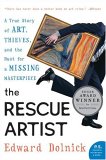Summary | Excerpt | Reading Guide | Reviews | Beyond the Book | Readalikes | Genres & Themes | Author Bio
A True Story of Art, Thieves, and the Hunt for a Missing Masterpiece

Critics' Opinion:
Readers' Opinion:
First Published:
Jun 2005, 270 pages
Paperback:
Jul 2006, 320 pages
Instead, they saw a celebration marred by shock and outrage. "In
this beautiful scenery," lamented the minister of culture, "it is hard to
imagine that such evil things could take place."
The thieves had no such somber thoughts. When they snatched
The Scream, they had left a postcard for the authorities to find. It showed
a painting by the popular Norwegian artist Marit Walle, who specializes
in cheerful, cartoon-like scenes of everyday life. Walle's Raging
Hormones, for instance, depicts two gray-haired matrons at the beach,
binoculars to their eyes, ogling young hunks. The thieves had made their
choice as carefully as shoppers in search of the perfect birthday card.
They had settled on a Walle painting called A Good Story. It shows
three men laughing uproariously, red-faced, pounding the table, gasping
for breath. On the back of the card one of the thieves had scribbled,
"Thanks for the poor security."
The security was worse than poor. "All the windows were locked,"
the
National Gallery's director, Knut Berg, told reporters. "We
didn't figure that thieves would climb through broken glass. There was a lot
ot
of glass. I wouldn't have dared to go through all that glass."
National Gallery officials, it soon became clear, had made a
string of bad decisions. The Scream had been moved from its customary
setting on the National Gallery's third floor to the second floor. That was more
convenient for visitors, since it was closer to the street, but more tempting to
thieves as well, for the same reason. Knut Berg had been museum director for
twenty years, and for twenty years he had done battle with the politicians who
controlled his budget. Now, on the brink of retirement, he had orchestrated a
can't-miss crowd-pleaser. As he watched his installers put the show together,
Berg had bustled about happily, beaming with anticipation.
His security chief was more wary. "From January through May
1994," he had instructed the museum guards in a memo, "Edvard Munch paintings
will be exhibited on the first floor [the second floor, in American usage] in
rooms 9, 10, and 12. Cameras . . . should be monitored throughout the night. The
night guard should vary his routine and should keep a special eye on the outside
walls of the exhibition area. This is a unique exhibition, on the first floor,
and we expect it to draw extra attention."
Bringing The Scream nearer to ground level was a blunder,
and installing the painting next to a window that opened on the street
compounded it.
Making matters worse still, the windows of the old brick museum
had no protective bars and were made of ordinary, rather than reinforced, glass.
The Scream was not bolted to the wall but hung from a wire, just
like an ordinary painting in an ordinary home, without any connection to the
alarm system.
The thieves had prepared carefully. Some of their scouting was
surreptitious.
They had found, for example, that the night guard finished his
rounds at about six in the morning and then retreated to his desk. But they
carried out much of their research at leisure and in the open, joining the
stream of visitors enjoying the "Festival of Norwegian Culture." The museum's
cameras were out-of-date, they saw, and left some vital areas uncovered. In room
10, there were no cameras at all.
Like most good planners, the thieves kept things simple. They
focused exclusively on The Scream, resisting the temptation to pick up
other baubles along the way. Nor did they bother with cutting phone lines or
disarming burglar alarms or any such electronic skullduggery. Speed was the key;
if the thieves could get in and out quickly enough, the best alarms would
provide little more than background noise.
From The Rescue Artist. Copyright © 2005 by Edward Dolnick. All rights reserved. Printed in the United States of America. No part of this book may be used or reproduced in any manner whatsoever without written permission except in the case of brief quotations embodied in critical articles or reviews. For information, address HarperCollins Publishers, 10 East 53rd Street, New York, NY 10022.





The Flower Sisters
by Michelle Collins Anderson
From the new Fannie Flagg of the Ozarks, a richly-woven story of family, forgiveness, and reinvention.

The House on Biscayne Bay
by Chanel Cleeton
As death stalks a gothic mansion in Miami, the lives of two women intertwine as the past and present collide.

The Funeral Cryer by Wenyan Lu
Debut novelist Wenyan Lu brings us this witty yet profound story about one woman's midlife reawakening in contemporary rural China.
Your guide toexceptional books
BookBrowse seeks out and recommends the best in contemporary fiction and nonfiction—books that not only engage and entertain but also deepen our understanding of ourselves and the world around us.